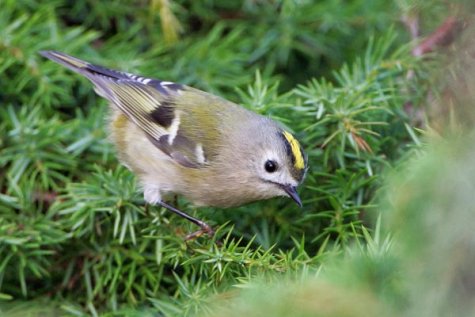The smallest migrants
Photo: Arne Ader
Translation:SilverT
Goldcrest
Goldcrest Pöialpoiss Regulus regulus
Europe`s smallest bird is less than ten centimeters tall and weighs only about five grams. Goldcrests are nesting everywhere where there are spruce forests, also towards the north and north-east from us, where they are also only partially migrants. Many of those who leave behind may not survive rough winters – this has been noticed in recent years. Groups of passing goldcrests can be seen feeding at us, migration mostly takes place at night.
Goldcrests have olive green feathers on their backs and light grey stomachs with a yellowish hue. The wings have two thin whitish stripes, the tail is short. The most noticeable characteristic is the golden longitudinal stripe on the crown with black edges; female birds have it in lighter colour. The golden stripe of the male bird has flaming red feathers in it and therefore the stripe looks darker. The dark brown eyes which are like pin heads have light grey spots around them, the beak is blackish brown and the feet are brown.
They often hang upside down from tree branches like tits and can remain flying in the air in the same spot for a few seconds like hummingbirds – the world`s smallest birds.
As the days are getting shorter, these tiny birds use most of the daytime searching for food. For birds who use insects for food all year-round, life is not easy during wintertime. They hunt arachnids, small insects and their larvae between thorns or leaves, springtails and mites from the cracks in the bark and forest debris which has fallen to the ground, but also from the moss which is covering rocks.
Goldcrests are nesting in spruce forest or mixed forests which have a majority of spruces. Passers can also be seen in pine groves and juniper thickets on the coast. In the winter, the numbers of goldcrests are about half a million individuals.
Goldcrest observations: LINK









